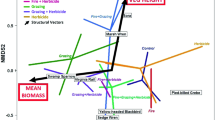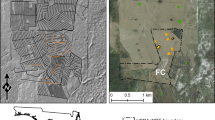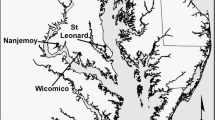Abstract
The Wetland Reserve Program (WRP) is one conservation tool used to mitigate national wetland loss, but few studies have evaluated the WRP for wildlife. During falls 2008 and 2009, we evaluated wetland plant communities and seed densities on 23 WRP wetlands in relation to 23 reference wetlands on managed public lands in the Willamette Valley and Lower Columbia River Valley (LCRV) of western Oregon and southwest Washington. Plant community on WRP easements differed by management intensity (A = 0.111, p = 0.002) with perennial and introduced species indicative of unmanaged easements and annuals indicative of actively managed wetlands, but plant community composition did not differ between WRP and reference wetlands (A = 0.003, p = 0.21). Overall, seed biomass was similar between WRP and reference wetlands (F 1, 41 = 2.44, p = 0.12), but this relationship varied by study region (F 1, 41 = 12.6, p = 0.001) related to management intensity. Seed biomass was greater on actively (765 ± 105 kg/ha) vs. passively (349 ± 105 kg/ha) managed sites (F 3, 34 = 9.90, p = 0.003). Seasonal wetlands on WRP easements can achieve a structure and function similar to reference sites. However, we suspect that in the absence of active management the value of WRP sites will decline as the plant community shifts to being dominated by introduced perennial species like reed-canary grass that will reduce the diversity of native wetland plants and lower seed abundance for waterbirds.

Similar content being viewed by others
References
Abraham K, Anderson M, Clark R, Colpitts L, Reed E, Bishop R, Eadie J, Petrie M, Rohwer F, Tome M, Rojo A (2007) North American waterfowl management plan continental progress assessment final report. http://www.fws.gov/birdhabitat/NAWMP/files/FinalAssessmentReport.pdf. Accessed 2 May 2011.
Anderson DH, Dugger BD (1998) A conceptual basis for evaluating restoration success. In: Wadsworth KG (ed) Transactions of the 63rd North American Wildlife and Natural Resource Conference, 20–24 March, 1998, Orlando, Florida. Wildlife Management Institute, Washington, pp 111–121
Benner PA, Sedell JR (1997) Upper Willamette River landscape: a historical perspective. In: Laenen A, Dunette DA (eds) River quality: dynamics and restoration. Lewis Publishers, New York, New York, USA, pp 23–47
Beyer HL (2004) Hawth’s analysis tools for AcrGIS. http://www.spatialecology.com/htools. Accessed 8 May 2008.
Brasher MG, Steckel JD, Gates RJ (2007) Energetic carrying capacity of actively and passively managed wetlands for migrating ducks in Ohio. Journal of Wildlife Management 71:2532–2541
Brinson MM, Malvarez AI (2002) Temperate freshwater wetlands: types, status, and threats. Environmental Conservation 29:115–133
Callicutt JT, Hagy HM, Schummer ML (2011) The food preference paradigm: a review of autumn-winter food use by North American dabbling ducks (1900–2009). Journal of Fish and Wildlife Management 2:29–40
Checkett JM, Drobney RD, Petrie MJ, Graber DA (2002) True metabolizable energy of moist-soil seeds. Wildlife Society Bulletin 30:1113–1119
Clark DL, Wilson MV (2001) Fire, mowing, and hand-removal of woody species in restoring a native wetland prairie in the Willamette Valley of Oregon. Wetlands 21:135–144
Dahl TE (2006) Status and trends of wetlands in the conterminous United States 1998 to 2004. U.S. Department of the Interior; Fish and Wildlife Service, Washington
Dufrêne M, Legendre P (1997) Species assemblages and indicator species: the need for a flexible asymmetrical approach. Ecological Monographs 67:345–366
Dugger BD, Cline ML, Finger RS, Petrie MJ (2007) True metabolizable energy of four common moist-soil seed species in the western U.S. Journal of Wildlife Management 71:1964–1967
Evans-Peters G (2010) Assessing biological values of Wetland Reserve Program wetlands for wintering waterfowl. Thesis, Oregon State University, Corvallis, USA
Fleishman E, Noss RF, Noon BR (2006) Utility and limitations of species richness metrics for conservation planning. Ecological Indicators 65:43–553
Fleming KS (2010) Effects of management and hydrology on vegetation, winter waterbird use, and water quality on Wetland Reserve Program lands, Mississippi. Thesis, Mississippi State University, University, USA.
Frazier S, Galat DL (2009) Analysis of Missouri Wetlands Reserve Program easement monitoring data. Final Report, Conservation Effects Assessment Project, Resource Inventory and Assessment Division, Natural Resources Conservation Service, Beltsville, Maryland, USA.
Fredrickson LH, Taylor TS (1982) Management of seasonally flooded impoundments for wildlife. U.S. Fish and Wildlife Resource Publication 148, Washington, D.C., USA.
Galatowitsch SM, van der Valk AG (1996) The vegetation of restored and natural prairie wetlands. Ecological Applications 6:102–112
Greer AK, Dugger BD, Graber DA, Petrie MJ (2007) The effects of seasonal flooding on seed availability for spring migrating waterfowl. Journal of Wildlife Management 71:1561–1566
Guard BJ (1995) Wetland plants of Oregon and Washington. Lone Pine Publishing, Renton
Hagy HM (2010) Winter food and waterfowl dynamics in managed moist-soil wetlands in the Mississippi Alluvial Valley. Dissertation, Mississippi State University, Mississippi State, USA
Hagy HM, Straub JN, Kaminski RM (2011) Estimation and correction of seed recovery bias from moist soil cores. Journal of Wildlife Management 75:959–966
Harmond JE, Brandenburg NR, Klein LM (1968) Mechanical seed cleaning and handling. Agricultural handbook no. 354, Agricultural Research Service, U.S. Department of Agriculture, Washington, D.C. USA.
Hicks BM (2003) Habitat contribution and waterbird use of Wetland Reserve Program sites in the Cache River Watershed, Illinois. Thesis, Southern Illinois University, Carbondale, USA
Hitchcock CL, Cronquist A (1978) Flora of the Pacific Northwest, 4th edn. University of Washington Press, Seattle
Hulse DW, Gregory S, Baker J (eds) (2002) Willamette River Basin Atlas: trajectories of environmental and ecological change. Oregon State University Press, Corvallis
Johnson GE, Thom RM, Whiting AH, Sutherland GB, Berquam T, Ebberts BD, Ricci NM, Southard JA, Wilcox JD (2003) An ecosystem-based approach to habitat restoration with emphasis on salmonids in the Columbia River estuary. Final Report, U.S. Army Corps of Engineers, Portland, Oregon, USA.
Kaminski RM, Davis JB, Essig HW, Gerard PD, Reinecke KJ (2003) True metabolizable energy of Wood Ducks from acorns compared to other waterfowl foods. Journal of Wildlife Management 67:542–550
Kaminski MR, Baldassarre GA, Pearse AT (2006) Waterbird responses to hydrological management of Wetlands Reserve Program habitats in New York. Wildlife Society Bulletin 34:921–926
Kentula ME, Gwin SE, Pierson SM (2004) Tracking changes in wetlands with urbanization: sixteen years of experience in Portland, Oregon, USA. Wetlands 24:734–743
King SL, Twedt DJ, Wilson RR (2006) The role of the Wetland Reserve Program in conservation efforts in the Mississippi River Alluvial Valley. Wildlife Society Bulletin 34:914–920
Kross J, Kaminski RM, Reinecke KJ, Penny EJ, Pearse AT (2008) Moist-soil seed abundance in managed wetlands in the Mississippi Alluvial Valley. Journal of Wildlife Management 72:1–8
Laubhan MK, Fredrickson LH (1992) Estimating seed production of common plants in seasonally flooded wetlands. Journal of Wildlife Management 56:329–337
Littell RC, Milliken GA, Stroup WW, Wolfinger RD, Schabenberger O (2006) SAS for mixed models, 2nd edn. SAS Institute, Inc., Cary
Martin AC, Barkley WD (1973) Seed identification manual, 2nd edn. University of California Press, Berkeley
McCune B, Mefford MJ (2009) PC-ORD. Multivariate analysis of ecological data. MjM Software, Gleneden Beach
Mielke PW (1984) Meterological applications of permutation techniques based on distance functions. In: Krishnaiah PR, Sen PK (eds) Handbook of statistics. Volume 4. Elsevier Science Publishers, Amsterdam, pp 813–830
Mitsch WJ, Wilson RF (1996) Improving the success of wetland creation and restoration with know-how, time, and self-design. Ecological Applications 6:77–83
National Research Council [NRC] (1995) Wetlands: characteristics and boundaries. National Academy Press, Washington
Natural Resources Conservation Service [NRCS] (2010) Conservation Programs. Wetlands Reserve Program. <www.nrcs.usda.gov/programs/wrp/index.html.>Accessed 8 Feb 2010.
Naylor LK (2002) Evaluating moist-soil seed production and management in Central Valley wetlands to determine habitat needs for waterfowl. Thesis, University of California, Davis, USA.
Olmstead VG (2010) Evaluation of management strategies on moist-soil seed availability and depletion on Wetland Reserve Program sites in the Mississippi Alluvial Valley. Thesis, Arkansas Tech University, Russellville, USA.
O’Neal BJ, Heske EJ, Stafford JD (2008) Waterbird response to wetlands restored through the Conservation Reserve Enhancement Program. Journal of Wildlife Management 72:654–664
Oregon Department of Fish and Wildlife [ODFW] (2006) Oregon conservation strategy. Oregon Department of Fish and Wildlife, Salem
Penny EJ, Kaminski RM, Reinecke KJ (2006) A new device to estimate abundance of moist-soil plant seeds. Wildlife Society Bulletin 34:186–190
Rewa CA (2005) Wildlife benefits of the Wetland Reserve Program. In: Haufler JB (ed) Fish and wildlife benefits of Farm Bill conservation programs: 2000–2005 update. The Wildlife Society Technical Review, Bethesda, pp 133–145
Institute SAS (2004) SAS/STAT user’s guide. SAS Institute, Cary
Seabloom EW, van der Valk AG (2003) Plant diversity, composition, and invasion of restored and natural Prairie Pothole wetlands: implications for restoration. Wetlands 23:1–12
Simpson EH (1949) Measurement of diversity. Nature 163:688
Summers, EA (2010) Evaluating ecological restoration in Tennessee hardwood bottomland forests. Thesis, University of Tennessee, Knoxville, USA
U.S. Department of Agriculture [USDA] (2010) Natural Resource Conservation Service, Plant Database. http://plants.usda.gov/ Accessed 3 April 2010.
U.S. Fish and Wildlife Service [USFWS] (2010) Division of Bird Habitat Conservation. North American Waterfowl Management Plan. http://www.fws.gov/birdhabitat/NAWMP/index.shtm. Accessed 8 April 2010.
Whittaker RH (1972) Evolution and measurement of species diversity. Taxon 21:213–251
Acknowledgments
We thank the Oregon Department of Fish and Wildlife, Pacific Coast Joint Venture, Washington Department of Fish and Wildlife, and the Department of Fisheries and Wildlife at Oregon State University for funding this research. We also appreciate the Natural Resource Conservation Service, Portland Metro, US Fish and Wildlife Service, and numerous private landowners for access to their land, and their time, knowledge, and assistance. Finally, we are indebted to J. Adams, S. Doddenhoff, T. Fox, C. King, S. Paroulek, B. Peters, and E. Weiner for help, friendship, and arduous labor in the field and lab.
Author information
Authors and Affiliations
Corresponding author
Rights and permissions
About this article
Cite this article
Evans-Peters, G.R., Dugger, B.D. & Petrie, M.J. Plant Community Composition and Waterfowl Food Production on Wetland Reserve Program Easements Compared to Those on Managed Public Lands in Western Oregon and Washington. Wetlands 32, 391–399 (2012). https://doi.org/10.1007/s13157-012-0275-y
Received:
Accepted:
Published:
Issue Date:
DOI: https://doi.org/10.1007/s13157-012-0275-y




